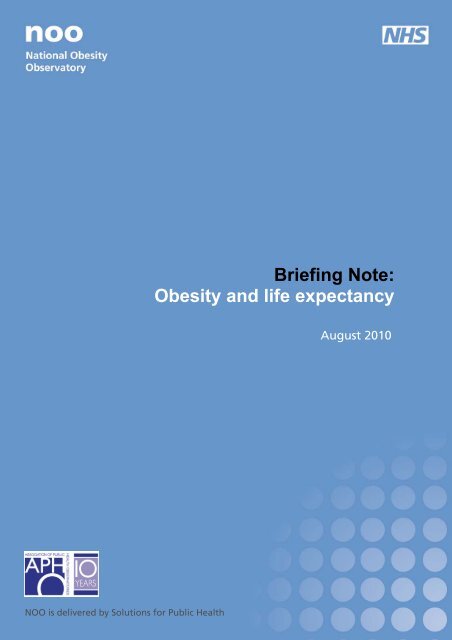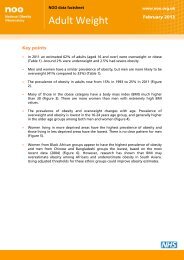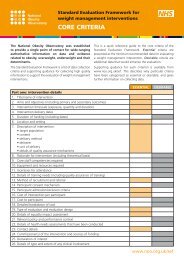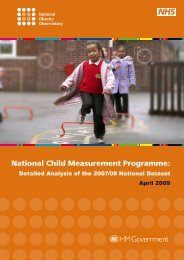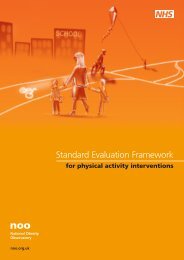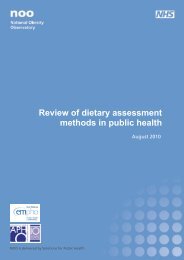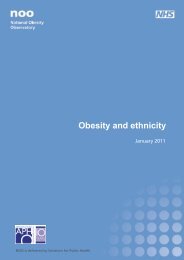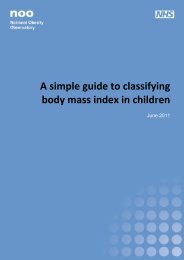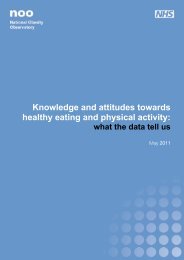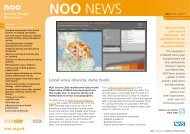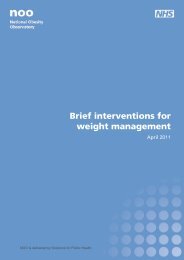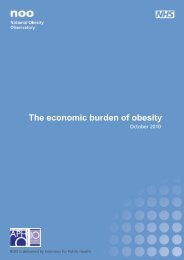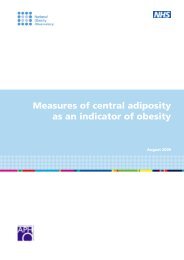Obesity and life expectancy - National Obesity Observatory
Obesity and life expectancy - National Obesity Observatory
Obesity and life expectancy - National Obesity Observatory
Create successful ePaper yourself
Turn your PDF publications into a flip-book with our unique Google optimized e-Paper software.
Briefing Note:<br />
<strong>Obesity</strong> <strong>and</strong> <strong>life</strong> <strong>expectancy</strong><br />
August 2010<br />
NOO | <strong>Obesity</strong> <strong>and</strong> <strong>life</strong> <strong>expectancy</strong> 1<br />
NOO is delivered by Solutions for Public Health
Summary<br />
A recent combined analysis of 57 international prospective studies found that Body Mass<br />
Index (BMI) is a strong predictor of mortality among adults. Overall, moderate obesity (BMI<br />
30-35 kg/m 2 ) was found to reduce <strong>life</strong> <strong>expectancy</strong> a by an average of three years, while<br />
morbid obesity (BMI 40-50 kg/ kg/m 2 ) reduces <strong>life</strong> <strong>expectancy</strong> by eight to ten years. This<br />
eight to ten year loss of <strong>life</strong> is equivalent to the effects of <strong>life</strong>long smoking.<br />
Key findings from studies investigating the impact of obesity on <strong>life</strong><br />
<strong>expectancy</strong><br />
The Prospective Studies Collaboration meta-analysis, published in the Lancet in March<br />
2009, 1 is the largest ever investigation of how obesity affects mortality. It brought<br />
together data from 57 long-term cohort studies mostly based in Europe, the US <strong>and</strong><br />
Australia <strong>and</strong> involving almost 900,000 participants. Participants were followed for an<br />
average of 10 to 15 years, during which 100,000 died. The study was co-ordinated by<br />
the Clinical Trial Service Unit (CTSU) in Oxford.<br />
Studies were eligible for inclusion in the analysis if they included BMI <strong>and</strong> mortality as<br />
outcome measures. BMI is calculated by dividing a person’s weight in kilograms (kg) by<br />
the square of their height in metres (m). People were excluded from the study if there<br />
was no record of their BMI or if they were severely underweight (BMI 50 kg/m 2 ).<br />
The effect of obesity on mortality <strong>and</strong> <strong>life</strong> <strong>expectancy</strong> at different levels of BMI (by<br />
about age 60 years) is summarised as follows:<br />
• in both sexes, mortality was lowest in the upper end of the ‘healthy’<br />
range (BMI 22.5–25 kg/m 2 );<br />
• average <strong>life</strong> <strong>expectancy</strong> was reduced by two to four years in the BMI<br />
range 30–35 kg/m 2 (international BMI classification ‘obese (class I’);<br />
• average <strong>life</strong> <strong>expectancy</strong> was reduced by eight to ten years in the BMI<br />
range 40–50 kg/m 2 (international BMI classification ‘obese (class III)’ or<br />
morbid obesity).<br />
These are the estimated effects of becoming obese by middle age. The effects on <strong>life</strong><br />
<strong>expectancy</strong> of becoming obese in childhood have not yet been precisely estimated.<br />
The study also revealed excess mortality at BMI levels well below 22.5 kg/m 2 . This effect<br />
is greater for smokers than non smokers <strong>and</strong> is not fully understood. The analysis<br />
excluded around 300 individuals with BMI 50 kg/m 2 or more so may have underestimated<br />
the health impact of morbid obesity.<br />
Although not a perfect measure of adiposity, BMI is a strong predictor of overall<br />
mortality both above <strong>and</strong> below the apparent optimum of 22.5 kg/m 2 . There is a<br />
progressive increase in all cause mortality above this range which is due mainly to<br />
vascular disease. Each 5 kg/m 2 increase in BMI is associated with about 30% higher<br />
overall mortality.<br />
a<br />
Life <strong>expectancy</strong> is the average number of years an individual of a given age is expected to live, if current<br />
mortality rates continue to apply.<br />
NOO | <strong>Obesity</strong> <strong>and</strong> <strong>life</strong> <strong>expectancy</strong> 1
By combining the relative risks of BMI with recent BMI population values, the authors<br />
predict that currently among middle-aged people (aged 50 years) in the UK, as many as<br />
23% of vascular deaths <strong>and</strong> 6% of cancer deaths will be attributable to overweight <strong>and</strong><br />
obesity.<br />
A number of other studies have estimated the impact of obesity on <strong>life</strong> <strong>expectancy</strong><br />
within the UK based on routinely available data. These include a study by Banegas et al,<br />
published in 2003, 2 <strong>and</strong> a study by Kelly et al from the University of Cambridge<br />
published in 2007. 3 Both of these studies estimated that around 9% of all deaths were<br />
attributable to excess adiposity. The Cambridge study modelled the impact of obesity<br />
on <strong>life</strong> <strong>expectancy</strong> <strong>and</strong> predicted that, over the period 2003 to 2015, population <strong>life</strong><br />
<strong>expectancy</strong> would be 0.28 years lower than it otherwise would be. This is comparable<br />
to the Foresight model which predicted that the increase in adiposity between 2004<br />
<strong>and</strong> 2015 would reduce <strong>life</strong> <strong>expectancy</strong> by about 0.11 years in men <strong>and</strong> 0.02 years in<br />
women. 4 It should be noted that these figures refer to average <strong>life</strong> <strong>expectancy</strong> for the<br />
whole population, hence will be lower than the <strong>life</strong> <strong>expectancy</strong> reductions identified in<br />
the Prospective Studies Collaboration publication for people who are obese.<br />
In addition, a large, recently published study in the US by Finkelstein et al, modelled <strong>life</strong><br />
<strong>expectancy</strong> using routine data. This showed a modest association between excess<br />
weight <strong>and</strong> <strong>life</strong> <strong>expectancy</strong> for those with BMI 25–35 kg/m 2 ; for those with BMI<br />
>35kg/m 2 , excess weight was associated with a significant reduction in <strong>life</strong> <strong>expectancy</strong>. 5<br />
Estimates of <strong>life</strong> <strong>expectancy</strong> based on modelling are likely to be less robust than those<br />
identified from cohort studies. Findings from modelling can also vary as a result of<br />
differences in analytical approach. 6<br />
References<br />
1. Prospective Studies Collaboration. Body-mass index <strong>and</strong> cause-specific mortality in<br />
900 000 adults: collaborative analyses of 57 prospective studies. Lancet 2009; 373:<br />
1083–96.<br />
2. Banegas JR, Lopez-Garcia E, Gutierrez-Fisac JL, et al. A simple estimate of mortality<br />
attributable to excess weight in the European Union. Eur J Clin Nutr. 2003; 57:201–8.<br />
3. Kelly C, Pashayan N, Munisamy S, et al. Mortality attributable to excess adiposity in<br />
Engl<strong>and</strong> <strong>and</strong> Wales in 2003 <strong>and</strong> 2015. Population Health Metr. 2009;7:11.<br />
4. McPherson K, Marsh T, Brown M. Tackling obesities: future choices – modelling<br />
future trends in obesity <strong>and</strong> the impact on health. 2. London: Foresight Programme,<br />
Government Office for Science; 2007.<br />
5. Finkelstein E, Brown DS, Wrage LA, et al. Individual <strong>and</strong> aggregate years-of-<strong>life</strong>-lost<br />
associated with overweight <strong>and</strong> obesity. <strong>Obesity</strong> 2010; 18 Vol 2: 333–9.<br />
6. Peters A, Bonneux L., Barendregt J, et al. Methods of estimating years of <strong>life</strong> lost due<br />
to obesity. JAMA: 2003 289; 2941.<br />
NOO | <strong>Obesity</strong> <strong>and</strong> <strong>life</strong> <strong>expectancy</strong> 2
Authors:<br />
Reviewers:<br />
Monica Dent, Di Swanston<br />
Gary Whitlock, Oxford University<br />
Louise Unsworth, North East Public Health <strong>Observatory</strong><br />
Contact:<br />
<strong>National</strong> <strong>Obesity</strong> <strong>Observatory</strong><br />
www.noo.org.uk<br />
info@noo.org.uk<br />
Electronic location: http://www.noo.org.uk/NOO_pub/briefing_papers<br />
Copyright<br />
© <strong>National</strong> <strong>Obesity</strong> <strong>Observatory</strong><br />
<strong>National</strong> <strong>Obesity</strong> <strong>Observatory</strong><br />
NOO | <strong>Obesity</strong> <strong>and</strong> <strong>life</strong> <strong>expectancy</strong> 3


